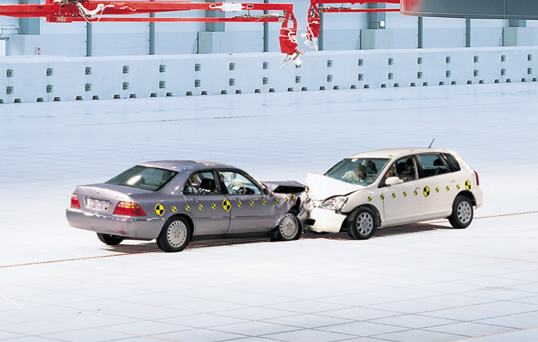Collision with the wall at a speed of 100 km / h, an unpleasant surprise

Two identical cars, each of which moves at a speed of 100 km / h, collide head-on. Is this equivalent to a collision with a concrete wall at a speed of 200 km / h?
An absolutely resilient cyclist at a speed of 100 km / h collides head-on with a heavy train, also moving at a speed of 100 km / h. Will the cyclist bounce at a speed of 300 km / h?
If you answered “ no, yes ” to the questions , then you are right and I will not tell you anything new. And the rest I invite to cat. There is no sophistry there.
Collision of two cars
In fact, a head-on collision of identical cars at a speed of 100 km / h is equivalent to a collision with a heavy wall at a speed of 100 km / h. Let's try to figure it out.
Consider the center of mass of these two machines, it is located exactly in the middle between them. During the collision, this center does not move. Moreover, it doesn’t matter if the cars are completely elastic, absolutely inelastic or real. Thus, at this point we can put a virtual wall. Note also that each of the two machines will absorb half the total energy of the system. Similarly, the same energy ( mV 2 /2 ) will absorb the vehicle enters a wall at the same speed.
So compare this collision with a collision of 200km / h illegally.
Collision of a cyclist with a train
We show that an absolutely resilient cyclist will bounce off the train at a speed of 300 km / h.
Absolute resilience will allow the cyclist not to turn into a cake, having lost all his energy and speed, and also to travel further on the windshield of the train.

Let cyclist speed v , and the speed of the train the W . Speeds are scalar (Figure 1).
- To get started, let's move on to the train reference system. By the theorem on the addition of speeds, it will turn into a stationary object, but the speed of the bicycle will increase and become equal to v + W (Figure 2)
- Since the collision is absolutely elastic, the cyclist will bounce at the same speed v + W (Figure 3)
- We turn back to the frame of reference of a stationary observer. All objects will start moving left to W faster. The train will go again, and the speed of the cyclist will increase to v + 2W (Figure 4)
- And since in our example v = W = 100 km / h, then the speed of the cyclist will become equal to 300 km / h
Using similar considerations, taking into account the laws of conservation of momentum and energy, a formula is derived for the velocities in an elastic collision.


Here u i are the velocities before the collision, v i are after, and m i are masses. Speed vector. By moving m 2 to infinity, we get the same result (do not forget that we have u 1 and u 2 in different directions).
Conclusion
I hope the task is not too trivial for Habr’s visitors, and my reasoning was clear to you. Otherwise, I run the risk of being outraged. If you do not agree with any of the items, or it is not clear enough, please indicate the item number in the comment.
Have a nice friday.
